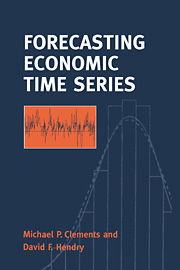Book contents
- Frontmatter
- Contents
- List of figures
- List of tables
- Preface
- Common acronyms
- 1 An introduction to forecasting
- 2 First principles
- 3 Evaluating forecast accuracy
- 4 Forecasting in univariate processes
- 5 Monte Carlo techniques
- 6 Forecasting in cointegrated systems
- 7 Forecasting with large-scale macroeconometric models
- 8 A theory of intercept corrections: beyond mechanistic forecasts
- 9 Forecasting using leading indicators
- 10 Combining forecasts
- 11 Multi-step estimation
- 12 Parsimony
- 13 Testing forecast accuracy
- 14 Postscript
- Glossary
- References
- Author index
- Subject index
9 - Forecasting using leading indicators
Published online by Cambridge University Press: 02 November 2009
- Frontmatter
- Contents
- List of figures
- List of tables
- Preface
- Common acronyms
- 1 An introduction to forecasting
- 2 First principles
- 3 Evaluating forecast accuracy
- 4 Forecasting in univariate processes
- 5 Monte Carlo techniques
- 6 Forecasting in cointegrated systems
- 7 Forecasting with large-scale macroeconometric models
- 8 A theory of intercept corrections: beyond mechanistic forecasts
- 9 Forecasting using leading indicators
- 10 Combining forecasts
- 11 Multi-step estimation
- 12 Parsimony
- 13 Testing forecast accuracy
- 14 Postscript
- Glossary
- References
- Author index
- Subject index
Summary
We now consider the use of indices of leading indicators in forecasting and macro-economic modelling. The procedures used to select the components and construct the indices are examined, noting that the composition of indicator systems gets altered frequently. Cointegration within the indices, and between their components and macroeconomic variables are considered as well as the role of co-breaking to mitigate regime shifts. Issues of model choice and data-based restrictions are investigated. A framework is proposed for index analysis and selecting indices, and applied to the UK longer-leading indicator. The effects of adding leading indicators to macro models are considered theoretically and for UK data.
- Type
- Chapter
- Information
- Forecasting Economic Time Series , pp. 207 - 226Publisher: Cambridge University PressPrint publication year: 1998

